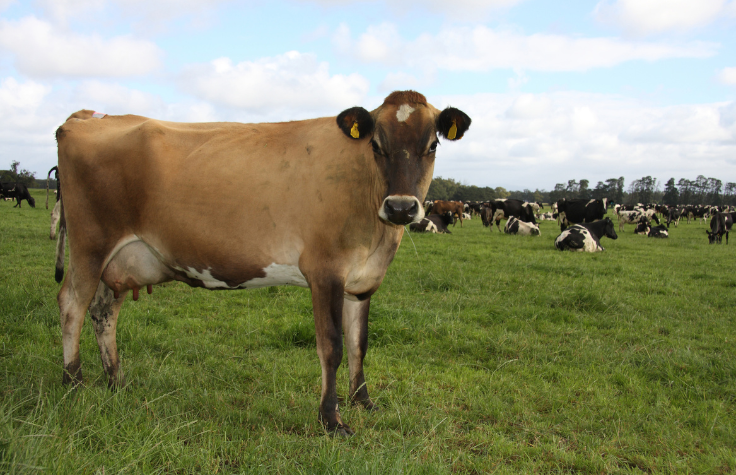A Lesser-Known Application of Genomics: Reducing Cow Burp Intensity
DataGene's Sustainability Index for dairy cattle herds combats this significant driver of global warming
NORTHAMPTON, MA / ACCESSWIRE / December 19, 2023 / Illumina
Originally published on Illumina News Center
Methane is 28 times more powerful a greenhouse gas than carbon dioxide: It's responsible for a third of global warming. A single cow can produce up to 500 liters of methane a day, or 160 kilograms per year, mostly through eructation (that is, belching). Multiply that by the planet's 1.4 billion cattle, and it might be a burp, not a butterfly wing, that causes a hurricane on the other side of the world.
Dairy foods continue to have an important role in feeding the world. It's not the cattle's fault that, by mass, there's more of them than any other mammal on earth (including us). Their digestive systems do what they can with the food we allot them. Given all this, what can researchers do to mitigate bovine belching? They can focus on cattle digestive systems. A cow's methane emissions are influenced by its gut microbiome, and evidence shows that their microbiome composition is influenced in turn by their genotype. Breeding cattle who simply emit less methane than their peers might be ideal-but this research is in its early stages.
How about focusing on cattle feed? Some studies have found that adding the methane inhibitor 3-nitrooxypropanol (3-NOP) to a cow's diet reduces their methane output by up to
"That will help, and potentially be a much faster improvement," says Matthew Shaffer. "Genetics is a long-term game. It takes time for genetics to work through the system. But the benefits of genetics are permanent and cumulative."
Shaffer is the CEO of DataGene, an initiative of Dairy Australia that's driving genetic gain and herd improvement in the country's dairy industry. DataGene publishes three indices that track desirable genetic traits among Australia's 1.4 million cattle: A Balanced Performance Index, for traits that affect their lifetime contribution to the farm business; a Health Weighted Index, which fast tracks genetic gain for fertility, feed efficiency, and disease resistance; and a Sustainability Index, which fast tracks genetic gain for reduced methane emissions intensity.
Thinking in these terms-not gross emissions, but emissions intensity-is another way to tackle the methane problem. Say you have two cows of the same weight, diet, and gross emissions, but every day one produces 20 liters of milk and the other 30 liters. The higher-producing cow dilutes their methane output across more production throughout their lifetime. "If you need to supply 100 liters of milk, you get it with less methane," Shaffer explains. "But with increased production comes other consequences, on fertility and other traits." For example, a longer-lived cow also has a reduced emissions intensity, because the first two years before she can begin producing milk constitutes a smaller percentage of her life. "That's why emissions intensity is balanced within our index: so we don't cause other issues by chasing only production."
Genomic sequencing has enabled dairy farmers to make breeding decisions much faster, with greater accuracy, based on genomic breeding values. No longer do they have to wait to see how productive, fertile, or hardy a bull's progeny are before they decide whether to use that bull for further breeding: These genomic breeding values can be calculated for animals as soon as they're born. This reduces the time between generations and, according to one estimate, saves bull breeding companies up to
Australian dairy farmers looking to order top-quality bull semen can use DataGene's apps to rank animals based on these indices, to fit their particular needs. They can also sequence their female animals simply by taking a small tissue sample, usually from an ear. They send the sample to a genomic service provider, who genotypes it and returns a genomic breeding value for that cow. Equipped with these values, farmers can make more informed decisions about which animals to keep in their herd.
"We couldn't do what we do without DairyBio, who provide a lot of the research and work closely with Illumina to add SNPs to their systems," Shaffer says, referring to the genetic markers that this genotyping looks for.
DataGene's next big project is aggregating vast amounts of new sequencing data into their Central Data Repository (CDR). "We're connecting the CDR to various equipment manufacturers to bring new data we've never seen before," Shaffer says. "Some of it will be milking machine information from robots; some will be information from companies we don't currently have access to. It's really important to expand the CDR, which will enable us to produce better tools and analytics for farmers."
It's not always the case that a company CEO starts out on the "shop room floor" in the same industry. But Shaffer grew up milking cows by hand on his grandmother's farm; his first paying job was as a milker on a larger farm. "So I've got milk in my veins, as it were," he jokes. But that means this work holds great personal meaning to him. "What gets me up every morning is the desire to enable farmers to make better decisions and breed better animals, and the corollary impact that has on the environment and on people's health."
With the strength of knowledge from all these tools, breeding a more sustainable cow is not just a good idea-it's a mooovement.

View additional multimedia and more ESG storytelling from Illumina on 3blmedia.com.
Contact Info:
Spokesperson: Illumina
Website: https://www.3blmedia.com/profiles/illumina
Email: info@3blmedia.com
SOURCE: Illumina
View the original press release on accesswire.com








